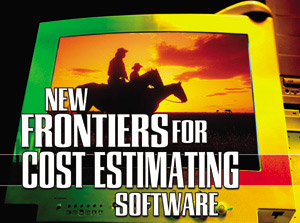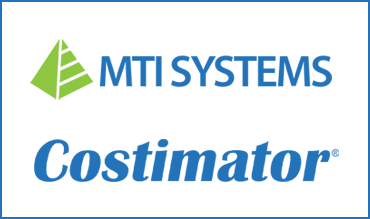-
-
Phone: 413-733-1972
New Frontiers for Cost Estimating Software

New Frontiers for Cost Estimating Software
By Thomas CharkiewiczA variety of innovative, profitable applications for Computer-Aided Cost Estimating (CACE) have evolved with new features that boost estimating accuracy and increase profits for both contract manufacturers and OEMs. Some companies also use CACE to cut waste and increase efficiency in areas such as job scheduling, shop floor management, quality control, product design, and most recently, purchasing and cost management. All in an attempt to be more competitive in a struggling manufacturing economy.
The "Real Cost" Concept
CACE is now being used by OEMs to determine the "real cost" of machined or fabricated parts purchased from suppliers. The prices OEMs typically pay for these components are market prices – whatever the market bears at that given point in time, regardless of the actual or true cost of making the part. But now purchasing agents and other manufacturing professionals can use accurate costing data from a CACE system to set realistic target prices for formulating and sending RFQs to their suppliers – making the RFQ process more effective and ultimately, lowering procurement costs.
One example of this was a large Midwestern heavy equipment manufacturer that used its new CACE system to calculate the true cost of a purchased custom chassis component. The system developed a real cost of $12 for a part that was being outsourced at $20. After reviewing the new information with his current supplier, the purchasing manager released RFQs to other suppliers using the $12 target price. One supplier bid came in at $11.75, which was $8.25 below what the company had been paying and $.25 below its target price, resulting in a $66,000 annual cost savings on that single component.
A CACE Primer
Features and benefits vary depending upon the system. All systems may used to play "what-if" to estimate different manufacturing scenarios, compare the impact of different tooling or materials, and avoid inaccuracy and cost overruns associated with manual estimation.
The most basic systems are spreadsheet programs without informational databases. They require manual insertion of machining and labor data. Basic system requirements vary.
The most comprehensive systems are typically priced on the high end and have databases using proven industry standards that can be tailored to incorporate unique labor rates, machine times and purchase parts costs. Some programs generate detailed routings and process plans as the estimate is created – ideal for managers and machinists to use in scheduling and set-up. These systems require at least an Intel Pentium II 266 processor, 64 MB RAM, Windows Me/98 or XP/2000. Additional hardware requirements include VGA or SVGA video adapter, an 800 x 600 resolution color monitor, a hard disk and CD-ROM.
More advanced systems electronically transfer machine and labor times to separate scheduling and enterprise systems for faster planning, improved accuracy, and increased profit. These systems require at least 300 MB available hard drive space before installation. A mouse and color printer (for reports) are basic system components.
Approaches to cost estimating vary. Some systems provide several options within a single package. Operation by operation estimating is the most comprehensive approach. It accounts for the time and cost of every routing step, from set-up to outside services to packing and shipping. It provides complex estimates in a fraction of the time of manual estimating. Feature-based estimating is faster. It estimates as quickly as the user points-and-clicks on part features and enters variables such as length of cut, diameter, and quantity. Historical cost data is used to set up the costs of manufacturing parts features. Once this data is established, the CACE program performs parametric calculations of manufacturing time and cost in a fraction of the time required for operation-by-operation estimates.
Suppliers also benefit from using CACE technology. Consider Carroll Machine Works (Pasadena, Texas), a precision machine shop serving large manufacturers in the aerospace, petrochemical, oilfield and gas industries. Their estimating department virtually eliminated "loser" jobs by knowing a part's real cost. "CACE helps us resist cutting corners and aggressively re-bidding a lower price to get the work," explains owner Wayne Carroll. "It's easier to say 'no thanks.'"
Buyers and suppliers who know the real cost of parts can intelligently and fairly negotiate with one another, build stronger relationships, and save money. Some OEMs that purchase a large dollar volume of parts require their suppliers to use the same estimating system. This creates a "standard estimating language" between the customer and supplier that streamlines the RFQ and purchasing processes within the supply chain.
Shop Rate Calculators are the most recent CACE technology to support purchasing. These higher-end programs scientifically determine shop rates – including labor and burden – for buyers and suppliers throughout the U.S. and overseas. Shop rate calculators help OEMs locate the most cost-efficient suppliers and enable purchasing departments to negotiate better pricing. Some systems allow the user to almost instantaneously compare part cost estimates from different areas of the world.
The data generated by Shop rate calculators assists the multi-location contract manufacturer in determining which plants can produce a part most economically. Further, the system allows them to find the best balance between profit maximization and competitive pricing of services. Some even use the shop rate calculator to determine what shop rates their competitors might bid for a job, giving them a competitive advantage.
Beyond Job Quoting
CACE technology has also been profitably utilized in four applications outside the job quoting arena. (Please note that some CACE systems may not be able to perform all these applications, as these systems vary in their configuration and capabilities):
"Front-ending" manufacturing management systems. Using integration breakthroughs such as Open Database Connectivity (ODBC) enable native links to client server systems (such as SQL Server and Oracle,)and allows more advanced systems to export feeds, speeds, labor standards and other data to MRP2, ERP and other scheduling and management systems. Electronically linking data is vital to beginning (front-ending) the planning and scheduling process. The fastest, easiest links for front-ending exist between two ODBC systems.
Early stages of part design. CACE is valuable in the initial stages of designing parts. An estimator can play "what if?" and quickly compare machining and labor costs for different design options to identify the most feasible one. Some estimators use CACE to collaborate with customers on designs that reduce manufacturing costs.
Quality control. Quality control personnel use CACE for ISO certification. A system with a flexible database can document and certify manufacturing processes and produce traceable documentation for inspection, as required by ISO guidelines. For example, Will-Burt Company (Orrville, Ohio) is a heavy equipment subcontractor whose CACE system enabled Quality Assurance to create process planning procedures that conform to ISO9000 criteria. "We purchased CACE to help achieve ISO certification," notes process engineering manager Kevin Baldwin. "It not only helps us meet ISO9000, it helps generate gains in shop floor efficiency, productivity and profitability."
 |
Planning and justifying capital equipment purchase. CACE system can be used to accurately estimate the costs of manufacturing pasts across different work centers or machines. These costs can be used to determine which machine offers the best return on investment. |
CACE and Lean Manufacturing
Companies should consider advanced CACE for supporting their transition into lean practices. The technology is inherently lean in its estimating accuracy and consistency. By improving efficiencies through electronic links to scheduling, planning, design engineering, etc., CACE promotes the lean methodology of kaizen, the Japanese word for the kinds of cross-company improvements and added efficiencies that are characteristic of lean manufacturing, and helps a company become continually leaner by –
- Breaking bottlenecks: CACE uncovers the most efficient manufacturing processes and front-ends the data needed for efficient scheduling.
- Supporting cellular manufacturing: CACE provides the necessary data to accurately schedule and coordinate the operations of multiple cells.
- Supporting Just-In-Time (JIT): CACE process plans, routings and data transferred to ERP advance the planning and smooth the flow of inventory needed for JIT.
Thinking Outside the Box
In these highly competitive times, a good strategy to increase business and boost profits might be letting CACE out of the "box" of job quoting. Beyond cost estimating purposes, CACE cuts waste, supports important planning, scheduling and purchasing decisions, and achieves cost reductions in key areas. Most importantly, it moves a company toward the world-class efficiencies achieved through lean manufacturing.
MTI Systems, 1111 Elm Street, Suite 6, West Springfield, MA 01089, 413-733-1972, Fax: 413-739-9250. www.mtisystems.com
Copyright © 2004, Cygnus Business Media. All Rights Reserved

Costimator®
Cost Estimating Software for Manufacturing
-
Cost Estimating Sheet Metal
-
Estimating for Machined Parts
-
Quoting for Machining and Fabrication




